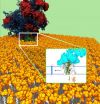Study shows breastfeeding reduced risk for ER/PR-negative breast cancer
2012-10-19
(Press-News.org) October 18, 2012 -- Breast-feeding reduces the risk for estrogen receptor-negative and progesterone receptor-negative breast cancer, according to a study conducted at Columbia University's Mailman School of Public Health. Researchers examined the association between reproductive risk factors — such as the number of children a woman delivers, breast-feeding and oral contraceptive use – and found an increased risk for estrogen receptor- and progesterone receptor- (ER/PR) negative breast cancer in women who do not breast-feed. The results also indicated that having three or more children without breast-feeding was associated with an increased risk for ER/PR-negative breast cancer. ER/PR-negative breast cancer often affects younger women and has a poor prognosis.
The paper was presented at the 11th Annual AACR International Conference on Frontiers in Cancer Prevention Research.
The researchers used data from three sites of the Breast Cancer Family Registry, which includes women with and without breast cancer from the U.S., Canada and Australia. The study included 4,011 women with breast cancer and 2,997 population-based controls.
"Women who had children but did not breast-feed had about 1.5 times the risk for ER/PR-negative breast cancer," said Meghan Work, MPH, doctoral student in the Department of Epidemiology and first author. "If women breast-fed their children, there was no increased risk for ER/PR-negative cancer. This is particularly important as breast-feeding is a modifiable factor that can be promoted and supported through health policy," Work said.
The investigators also found that oral contraceptive use was not associated with ER/PR-negative cancer risk, with the exception of those formulations available before 1975. "These earlier formulations contained higher doses of estrogen and progestin than more recent versions," Work said.
These results are in line with previous findings that have demonstrated a breast-feeding benefit in triple-negative breast cancer, which includes estrogen and progesterone receptor negative cancers. "The consistency of the association with breast-feeding and estrogen receptor negative tumors across a number of studies is particularly noteworthy as there have been few modifiable risk factors identified for this tumor subtype," said Mary Beth Terry, PhD, associate professor of Epidemiology and senior author of the paper.
INFORMATION:
Support for the study was provided by the National Cancer Institute and Breast Cancer Research Foundation. Co-principal investigators were Drs. Esther John, Irene Andrulis, and John Hopper.
END
ELSE PRESS RELEASES FROM THIS DATE:
2012-10-19
OAKLAND, Calif., Oct. 18— A U.S. Food and Drug Administration-funded study led by the Kaiser Permanente Northern California Division of Research found an increased risk of arterial thrombotic events (ATE) and venous thromboembolic events (VTE) — commonly referred to as blockage of arteries and blood clots, respectively — associated with drospirenone-containing birth control pills compared to four low-dose estrogen combined hormonal contraceptives.
The study appears in the current online issue of Contraception.
"We found that starting use of drospirenone-containing combined ...
2012-10-19
PASADENA, Calif.—Chemists at the California Institute of Technology (Caltech) have managed, for the first time, to simulate the biological function of a channel called the Sec translocon, which allows specific proteins to pass through membranes. The feat required bridging timescales from the realm of nanoseconds all the way up to full minutes, exceeding the scope of earlier simulation efforts by more than six orders of magnitude. The result is a detailed molecular understanding of how the translocon works.
Modeling behavior across very different timescales is a major ...
2012-10-19
HOUSTON - Low depressive symptoms and a longer telomere length are compelling factors that contribute to a prolonged life for bladder cancer patients according to researchers at The University of Texas MD Anderson Cancer Center.
In an observational study, a team of MD Anderson researchers analyzed clinical and behavioral data collected from 464 bladder cancer patients, according to research presented at the 11th Annual AACR International Conference on Frontiers in Cancer Prevention Research.
"This is the first study of its kind that analyzes bladder cancer outcomes," ...
2012-10-19
Certain types of routes carry much lower risk of injury for cyclists, according to a new University of British Columbia study on the eve of Vancouver's Bike to Work Week.
The study, published today in the American Journal of Public Health, analyzed the cause of 690 cycling injuries in Vancouver and Toronto from 2008 to 2009 and various route types and infrastructure.
The greatest risk to cyclists occurs when they share major streets with parked cars, with no bike lanes present – like on Broadway in Vancouver or Dundas Street in Toronto. Without a designated space on ...
2012-10-19
Bethesda, MD, October 18, 2012 The Association for Molecular Pathology (AMP) published the
report of the Whole Genome Analysis (WGA) Working Group of the AMP Clinical Practice Committee
in the November 2012 issue of The Journal of Molecular Diagnostics (JMD). Titled "Opportunities and
Challenges Associated with Clinical Diagnostic Genome Sequencing," the timely report provides a
detailed and compelling overview of the landscape of next generation sequencing (NGS) technology
and its clinical relevance and impact on improving patient care. The issues addressed in the ...
2012-10-19
Boston, MA— Excitement around the potential for targeted nanoparticles (NPs) that can be controlled by stimulus outside of the body for cancer therapy has been growing over the past few years. More specifically, there has been considerable attention around near-infrared (NIR) light as an ideal method to stimulate nanoparticles from outside the body. NIR is minimally absorbed by skin and tissue, has the ability to penetrate deep tissue in a noninvasive way and the energy from NIR light can be converted to heat by gold nanomaterials for effective thermal ablation of diseased ...
2012-10-19
We live in a human-dominated world. For many of our fellow creatures, this means a fragmented world, as human conduits to friends, family, and resources sever corridors that link the natural world. Our expanding web of highways, cities, and intensive agriculture traps many animals and plants in islands and cul-de-sacs of habitat, held back by barriers of geography or architecture from reaching mates, food, and wider resources.
A team of researchers, managers, and ecological risk assessors review the current state-of-the-art in landscape connectivity planning, offering ...
2012-10-19
People are more likely to install a solar panel on their home if their neighbors have one, according to a Yale and New York University study in the journal Marketing Science.
The researchers studied clusters of solar installations throughout California from January 2001 to December 2011 and found that residents of a particular zip code are more likely to install solar panels if they already exist in that zip code and on their street.
"We looked at the influence that the number of cumulative adoptions—the number of people who already installed solar panels in a zip ...
2012-10-19
It's fall football season, when fight songs and shouted play calls fill stadiums across the country. Another less rousing sound sometimes accompanies football games: the sharp crack of helmet-to-helmet collisions. Hard collisions can lead to player concussions, but the physics of how the impact of a helmet hit transfers to the brain are not well understood. A research team from the U.S. Naval Academy in Annapolis, Md., has created a simplified experimental model of the brain and skull inside a helmet during a helmet-to-helmet collision. The model illustrates how the fast ...
2012-10-19
Global temperatures directly affect the acidity of the ocean, which in turn changes the acoustical properties of sea water. New research suggests that global warming may give Earth's oceans the same hi-fi sound qualities they had more than 100 million years ago, during the Age of the Dinosaurs.
The reason for this surprising communication upgrade is that whales vocalize in the low-frequency sound range, typically less than 200 hertz, and the new research predicts that by the year 2100, global warming will acidify saltwater sufficiently to make low-frequency sound near ...
LAST 30 PRESS RELEASES:
[Press-News.org] Study shows breastfeeding reduced risk for ER/PR-negative breast cancer

